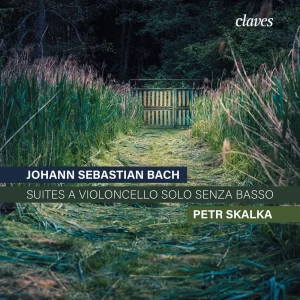
Petr Skalka Six Suites for Violincello Senza Bassa (Claves 50-3101/02) Recorded 2020
Instruments and Bows :
Giuseppe Guarneri filius Andreae ca.1700
Dalibor Bzirny, Praga 2018 op.224
Anonymous bow, mid 18th century
Fausto Cangelosi baroque bow copy
So, I now turn to another of those growing band of recordings about which we can legitimately say – played by who? Certainly, Skalka appears little recorded in his own right, although he has taken part in a number of award winning ensemble recordings. Born in the Czech Republic, his interest in early music and historical performance practice eventually led Skalka to the highly regarded cellist/teacher Christoph Coin at the Schola Cantorum Basiliensis. Skalka has himself subsequently gone on to teach at the school. He is thus very well versed in period performance, and this is reflected in the recording.
Skalka prefaces his fascinating text notes with the following quote, apparently the beginning of the first written cello method by Michel Corente:
“Noble Pillar of harmony,
you are a majesty to us,
through your divine melody (the bass line)
you give soul to our concerts”
Skalka is also a fan of the cello’s capabilities, and especially those bass elements. He points out Bach’s reference to the pieces as “senza bassa” (without bass) merely means that the bass lines are an integral part of the works. Skalka’s own love of the bass elements certainly comes through big time in his performances. The sound itself (type of venue unspecified, but I doubt it’s a chapel) is full on and a bit forward. I found it extremely exciting, but some may find it a bit too much. The slightly forward soundstage does provide a bit of limitation in the width but it’s best described as just like a cello is being played in the room. The notes infer, and the sound backs up, that gut strings have been used.
Throughout the listening session, I often thought of David Watkin’s outstanding period performances of the suites. Their track timings are not so dissimilar, but with odd notable exceptions, principally the 4th Suite Bourrees (Watkin nearly twice as long!) and the 5th Suite Prelude (Watkin c.1.5 minutes longer).
Skalka presents his suites in chronological order but with 2 interesting additions. Firstly, he prefaces the 1st Suite with an initial short improvisation which utilises the harmonic progression of the Prelude itself with ornamental elements form the adagios of Corelli’s Op.5. Is it necessary? Of course not, but I rather enjoyed it and the transition was not jarring. Secondly, he also includes his own transcription of the Passacaglia for violin “The Guardian Angel” from Biber’s Rosary Sonatas. This lasts almost 10 ten minutes and I think is very well done and a noteworthy addition to the solo cello repertoire.
The first 3 suites I was very impressed by, although the hell for leather 2nd Suite Courante did feel a little unusual in its more measured surroundings. They are exciting, virile, and well executed performances giving full range to the rich deep sounds of the cello. Given the apparent close miking there were inevitably going to be some fingerboard noises from the playing but, and here’s the rub, given the compensations, for once I really didn’t care that much! Halfway there and I was one very satisfied customer.
Suites 4-6 were still very pleasing overall but there were a few more caveats. I found the 4th Suite Sarabande a bit turgid, and the 5th Suite Prelude uses clipped notes which sacrifices what for me are crucial harmonic overtones normally best achieved within seamless lines. Furthermore, my much favoured 6th Suite Sarabande was not as moving as I like, and not helped on this occasion by additional ornamentations, perfectly legitimate to period practice, but I feel better applied elsewhere. However, Skalka gets things back on track for the final 2 movements, ending with a rousing Gigue.
I believe the 6th Suite is being played on the Dalibor cello (Dalibor Bzirny being a renowned contemporary Luthier, thus I take the instrument listed at the top to be a cello). It certainly sounds lighter in tone, and there is unquestionably more or the top of the range coming through.
How to summarise? Well, if you are looking for the sound of the steel strung cello with its freer sweeter top range this is probably not for you. However, if you are a period instrument fan, or just more broadly inquisitive by nature, this could be just the ticket. Skalka’ clipped rhythms are certainly dance like and so full of life. However, if you favour the many colours and overtones that others can produce, or even forensic details, you won’t find them here. On the other hand, the sheer power of the bass when its lower register is allowed to bloom is impressive. I enjoyed it a lot. Whether it would ever replace Watkin as my established period reference only time will tell. My gut feel is not, but I fully intend to revisit them to try and find out. I think that is a recommendation in itself……
Mark